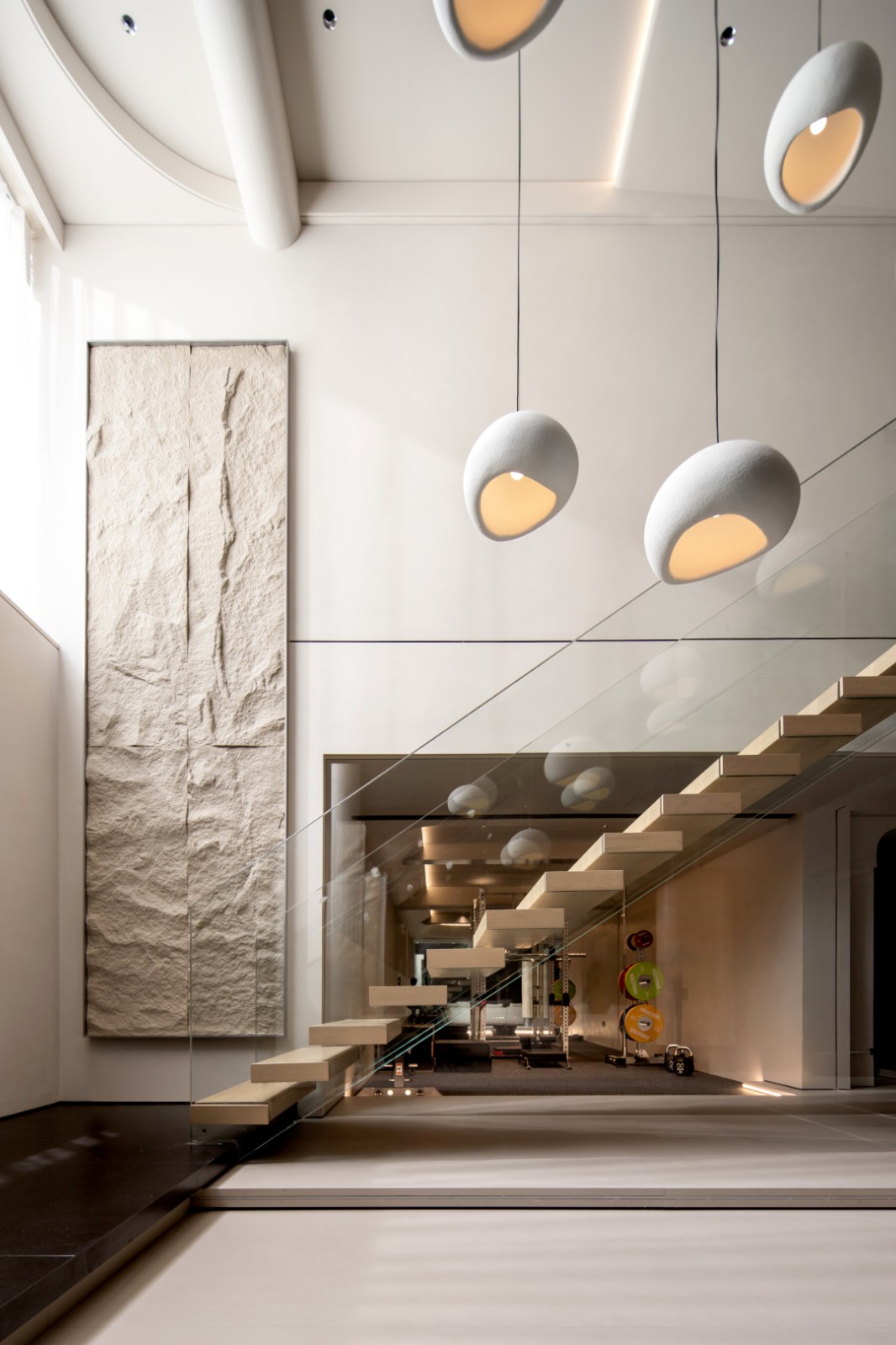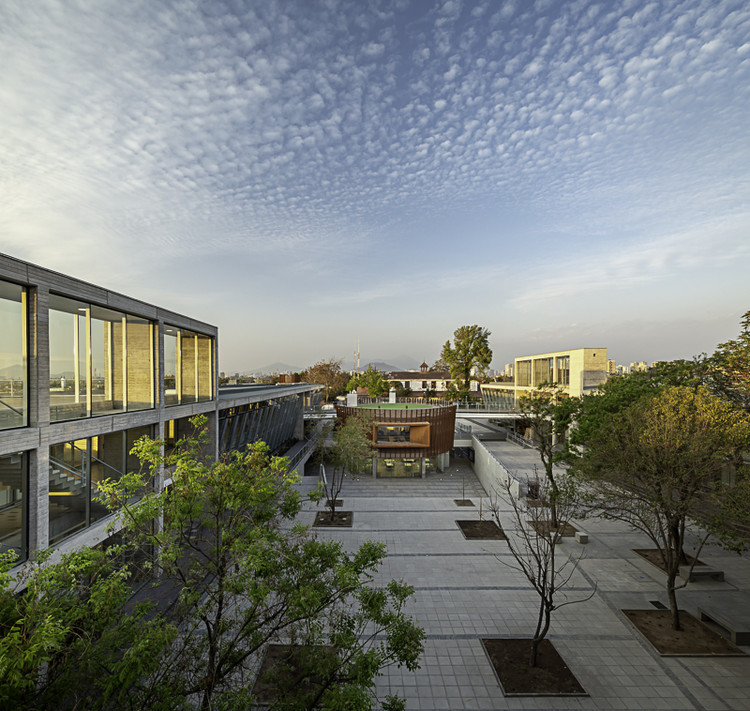Corner House DSDHA
2016-12-20 03:00
© Christopher Rudquist
克里斯托弗·鲁德奎斯特


架构师提供的文本描述。DSDHA与德温特·伦敦合作,在伦敦中心的菲茨罗维亚建造了一座谨慎而又诱人的砖角建筑,在与伦敦更广泛的环境进行积极对话的同时,也给周围环境带来了欢乐。
Text description provided by the architects. DSDHA has worked in collaboration with Derwent London to deliver a discreet yet alluring brick corner building in Fitzrovia, central London, that brings delight to its surroundings while engaging in an active dialogue with the wider context of the city.
© Christopher Rudquist
克里斯托弗·鲁德奎斯特


角落之家致力于引进一种新型的当代美,一种不那么华而不实但又吸引人的美,以其位置的质量为基础,提供一种高度可持续的解决方案,体现高质量的设计和工艺。
Corner House strives to introduce a new type of contemporary beauty, one which is less ostentatious yet captivating, building on the qualities of its location to provide a highly sustainable solution that embodies high quality design and craftsmanship.
© Luca Miserocchi
卢卡·米塞罗奇


在城市层面,它庆祝的是普通的街角,而角屋(Corner House)则颠倒了这种类型(通常在地面上呈现出更清晰的外观),并在屋顶上放置了两颗宝石,就像水晶亭台楼阁,在伦敦ʼ的杂乱多变的屋顶景观上展现了一系列意想不到的景象。
While at an urban level it celebrates the ordinary street corner, Corner House inverts this typology (typically presenting a more articulated treatment of the façade at the ground level) and places two jewel like crystalline pavilions on the rooftop, opening up a series of unexpected views onto Londonʼs variegated and ever changing roofscape.
Axonometric


街角屋提供了私人和负担得起的房屋的混合,以及在底层的商业空间。这栋楼高6层,共有11套公寓,9套私人公寓和2套可负担的公寓,所有这些都是双人间或三层房,有着非常高的采光水平。
Corner House provides a mix of private and affordable homes, along with a commercial space on the ground floor. Over its six-storeys the building comprises 11 apartments, nine private and two affordable, all of which comprise double or triple aspect rooms with exceptional levels of daylighting.
© Helene Binet
海琳·比内
.jpg)

原来的土地由三幢不同的建筑物组成,后来被一个大型的现代化方案所取代。“街角屋”试图将原有建筑的特征重新呈现出来,将它们的身份整合成一个街区,反映周围街道的城市等级-宏伟的夏洛特街(夏洛特街)和更安静的托特纳姆街(Tottenham Street),以及托特纳姆梅斯(Tottenham Mews)更实用的身份。
The original site comprised three distinct buildings, which were subsequently replaced by a large modern scheme. Corner House attempts to bring back the character of the original structures, consolidating their identities into a single block that reflects the urban hierarchy of the surrounding streets – the grander Charlotte Street and quieter Tottenham Street, and the more utilitarian identity of Tottenham Mews.
© Christopher Rudquist
克里斯托弗·鲁德奎斯特


角屋的入口处被配置成能适应当地的环境;商业单元面对着夏洛特街的嘈杂大道和它的商业前沿;公寓在安静的街道上有入口和门廊。
The entrances to Corner House are configured to respond to the local context; the commercial unit faces the noisy thoroughfare of Charlotte Street with its commercial frontages; the apartments have entrances on the quieter street and mews.
© Luca Miserocchi
卢卡·米塞罗奇


屋顶上的楼阁为该项目提供了一个隐蔽的地形,只有在询问后才会显现出来,占用了邻近建筑物建立的光权信封。街角屋并不会破坏邻里之间坚实的砖墙表面的一致形态-然而,位于最顶层的略微倾斜的窗户的平移面表明了一些意想不到的事情。
The pavilions on the roof offer a hidden terrain to the project that only becomes apparent upon enquiry, occupying as they do the Rights Of Light envelope established by neighbouring buildings. Corner House does not disrupt the consistent morphology of the solid brick facades that characterise the neighbourhood – however the shifting planes of its slightly angled windows on the uppermost floor suggest something unexpected.
© Luca Miserocchi
卢卡·米塞罗奇


无人机摄影、卫星视图和新的测绘技术改变了我们对城市景观的理解和导航方式。我们现在习惯于主要从上面想象后者,其结果是屋顶已成为相关的第五高度。角楼立面和亭子的铰接式几何学反映了这一视角的转变,它增加了焦点,消解了传统的线性视角,从而提出了一个可供选择的维度来欣赏建筑及其周围的景观。技术上的挑战,但看似令人震惊的简单,他们是在一个毫不费力的对话与其他屋顶结构散落在地平线附近。
Drone photography, satellite views and new forms of mapping technologies have changed the way we understand and navigate the urban landscape. We are now accustomed to visualise the latter mainly from above, with the consequence that the roof has become a relevant fifth elevation. The articulated geometry of Corner House facade and pavilions reflects this perspectival shift, it multiplies focal points and dissolves traditional linear perspective therefore suggesting an alternative dimension from which to appreciate the building and its surrounding views. Technically challenging yet appearing disarmingly simple, they are in an effortless dialogue with other roof structures scattered on the horizon nearby.
© Helene Binet
海琳·比内
_altered.jpg)

与大多数使用砖瓦作为非结构包层的新项目不同,在这里,建筑物主体的砖瓦是自给的,承受自身的巨大重量,从而减轻上层建筑的负荷,并将用于工程的混凝土的数量及其生产中所体现的能量降到最低。本来可以成为一个整体的外观是通过使用石灰灰浆,以消除膨胀节,并定制金属工作栏杆。
Unlike most new projects that use brickwork as a non-structural cladding, here the brickwork for the main body of the building is self-supporting, bearing its own substantial weight, thereby relieving loading on the superstructure, and minimising amount of the concrete used on the project and the energy embodied in its production. What could have become a monolithic façade is refined by the use of lime mortar, to eliminate expansion joints, and bespoke metal work balustrades.
© Helene Binet
海琳·比内
.jpg)

DSDHAʼ对夏洛特街ʼ保护区的分析为设计提供了信息,并确保了相关的响应。该设计旨在恢复典型的菲茨洛夫阶地的一些关键的当地特色,例如强调垂直性,在这种垂直性中,高地平线标志着桥墩体屋顶的三方划分,带有穿孔的砖石建筑,以及墙窗比高的砖石结构。
DSDHAʼs analysis of Charlotte Streetʼs Conservation Area informed the design and ensured a contextual response. The design seeks to restore some key local features of typical Fitzrovian terraces, such as an emphasis on verticality where strong horizon lines mark a tripartite division of plinth-body- roof, masonry construction with punched apertures and a high ratio of wall to window.
© Christopher Rudquist
克里斯托弗·鲁德奎斯特


建筑立面的阶梯性揭示是延伸的研究和测试的结果,以捕捉砖石建筑的工艺,但它受到塑性的处理,以达到显著的效果。定制的过梁有助于跨越彼此成比例地相互关联的托架,这反映了大多数FitzoViae的建筑的几何推导。因此,每个地板在窗台和内部地板水平之间具有稍微不同的关系,使得建筑物看起来不那么坚固地堆叠和精细地区分开。
The stepped reveals to the facades were the result of extended research and testing to capture the craftsmanship of masonry construction yet it is treated with plasticity to achieve a dramatic effect. Bespoke lintels help span the bays which relate proportionally one to another, reflecting the geometric derivations of most of Fitzroviaʼs architecture. As a result each floor has a slightly different relationship between the sill and the internal floor levels, making the building appear less relentlessly stacked and subtly differentiated.
© Christopher Rudquist
克里斯托弗·鲁德奎斯特


角落大厦是一个更广泛的复兴计划的一部分,以改善和恢复菲茨罗维亚的性格,在跨铁路到达托特纳姆法院路2018年。拥有超过36%的房地产投资组合位于菲茨罗维亚,德温特伦敦与其社区有着良好的关系,并与伦敦卡姆登区密切合作,他们能够以整体的方式重新开发伦敦市中心的这一地区。角屋位于萨福克大厦(Suffolk House)半径500米的范围内。萨福克大厦曾是DSDHA在2014年将其改建为德温特·伦敦(Dergo London)的廉价住宅。阁楼坐落在现有的建筑物上,其三角形屋顶景观与角楼的展馆屋顶景观共享一种正式的语言。
Corner House is part of a wider regeneration plan to improve and restore the character of Fitzrovia ahead of the arrival of Crossrail to Tottenham Court Road in 2018. With over 36% of its property portfolio located in Fitzrovia, Derwent London have a good relationship with its community and working closely with London Borough of Camden they have been able to redevelop this part of central London in a holistic way. Corner House is within a 500m radius of Suffolk House, a former warehouse building that DSDHA converted and extended into affordable residential accommodation for Derwent London in 2014. The attic floor sits lightly on the existing building and its triangulated roofscape shares a formal language with the pavilion roofscape of Corner House.
© Christopher Rudquist
克里斯托弗·鲁德奎斯特


在角落的西边,DSDHA领导着托特纳姆法院路周围的公共领域的复兴。托特纳姆法院路是由伦敦卡姆登区委托的,现在才刚刚开始。DSDHA设计了一项高度可持续的交通方案,并设计了新的ʻ袖珍ʼ公园,这些公园在该地区的每一段行程中穿行,降低了人们与城市这一独特部分接触的速度。
To the west of Corner House DSDHA is leading the rejuvenation of the public realm around Tottenham Court Road, a commission by the London Borough of Camden which is just starting on site. DSDHA have devised a highly sustainable transport scheme and designed new ʻpocketʼ parks, which punctuate the individual journeys through the area, lowering the speed at which one engages with this unique part of the city.
© Christopher Rudquist
克里斯托弗·鲁德奎斯特










.jpg)

.jpg)











.jpg)



.jpg)

_altered.jpg)















.jpg)



.jpg)









Architects DSDHA
Location Margaret Pyke Centre, 73 Charlotte St, Fitzrovia, London W1T 4PL, UK
Category Commercial Architecture
Project Team Deborah Saunt, Tom Greenall, Matthew Lambert, Arnold Seligmann, Deb Adams, Natasha Reid, Luke Jackson, Jeremy Corminboeuf, Marine Fleury, Marianna Filippou
Area 1800.0 m2
Project Year 2015
Photographs Luca Miserocchi
































